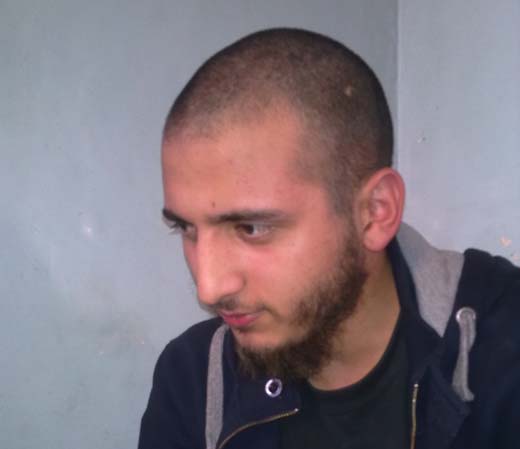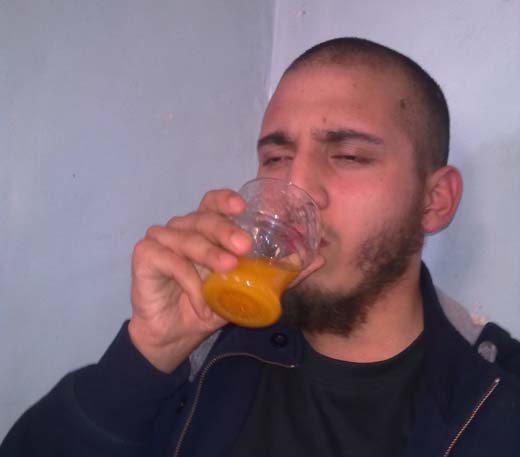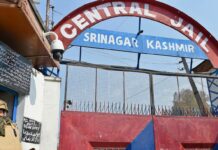The debate about use of lethal weapons like pellet guns might have died down for a while but the victims are living a long dark life. Saima Bhat talks to one such victim whose promising future was cut short by a pellet injury.

A quite Sunday afternoon in July 2013 turned fatal for twenty-one-year old Hayat Ashraf Dar, a BA economics student at Jamia Milia Islamia, New Delhi, who was visiting his grandparents in Kashmir during summer break. That day, Hayat was on his way home after attending a function in uptown Srinagar, when the bus he was travelling in came to an abrupt halt near his house. He was told that there are protests going on in Nowhatta area and it is not safe to go there. Hayat de-boarded the bus and decided to walk the remaining distance. In order to avoid the Jamia Masjid area, which in last few years has been centre of pitched battle between stone-pelters and state police, Hayat took a short de-tour to reach his grandparent’s house.
As he reached near Jamia Masjid, he saw youngsters engaged in ding-dong battle with police. It was a chaotic scene. The air was heavy and filled with tear-smoke. Both sides were shouting loudly at each other. Terrified, he decided to leave immediately. It was the holy month of Ramadhan. Somewhere nearby Hayat heard muezzin calling faithful for Asar prayers. But the muezzin’s call was lost in the noise created in front of the historic Jamia Masjid. Hayat was surprised to see policemen hurl choicest abuses at protestors who in turn pelted stones. It pained young Hayat. He could not control himself and shouted his lungs out towards a Kashmiri policeman whom he thought was a Muslim. “Don’t you have any respect for Ramadan? Can’t you hear the Azan (call for prayers)?” he shouted again and again until he caught policeman’s attention.
The policeman holding a long barrelled pellet gun in his hands pointed it towards Hayat. And in a flash, before Hayat could react, everything went dark in front of his eyes. “All I could remember is that I was in pain. White light had filled my eyes. And then it went all black suddenly,” says Hayat.
Sitting in a corner of a small room at his grandparent’s house, Hayat looks like any other normal youngster of his age. He is surrounded by his childhood friends and relatives. The room is filled with light from a big window that opens in a small courtyard of the house. He spends his days sitting indoors in his room. His days start at 6 in the morning when he offers morning prayers. His only possession: his mobile phone that rests near his pillow. But despite his blindness, Hayat stays abreast with the latest happening in Kashmir and world. Hayat’s cousin, who is studying in 8th standard, is his navigator and companion. “He helps me with my day to day affairs. I don’t let him go to school until he reads full newspaper for me in the morning,” says Hayat. In last three months Hayat has learned to take care of himself. “I need help when I feel like walking around in the house. It is really difficult to find my way to loo,” says Hayat.
In last three months Hayat had undergone four surgeries in his right eye. The pellets fired by the agitated policeman had hit Hayat in both his eyes. Doctors have told him that the pellet in his right eye has cut its nerve and the pellet in left eye has broken down its retina.
Hayat points towards his right hand showing a small pellet which is still there. Some pellet had missed his heart by a whisker.
In order to restore his vision Hayat’s father took him to different places like AIIMS (New Delhi) Indore (Madhya Pradesh) and Hyderabad, but nothing helped.
On a recent visit to AIIMS doctors assured Hayat that he might be able to see with his right eyes after three months. “But there is no surety,” says Hayat in a voice filled with hope. The pellet is still in his left eye.
In last two-and-a-half decades of conflict scores of Kashmiri families migrated to different parts of India to earn a livelihood. Hayat’s father, a small time Kashmiri handicrafts trader shifted to New Delhi in 2002, along with his wife and youngest son, hoping to earn a modest living, and above all keep them safe.
Hailing from Nowhatta area in downtown Srinagar, Hayat stayed back with his grandparents for a couple of years. In 2004, when Hayat was in 6th standard, his father took him along and he continued his studies in New Delhi. From that day onwards Kashmir became a summer holiday place for Hayat and his family. Hayat would visit Kashmir during his vacations and stay with his grandparents. During his visits to Kashmir he used to catch up with his childhood friends as he hardly made any new ones in New Delhi.
An undergraduate in economics at Jamia Milia Islamia, Hayat wishes to study politics or peace and conflict studies in future.
While in Delhi, Hayat was always in touch with the situation in Kashmir. During the recent unrest his close relatives have witnessed four deaths in the family. Three of the four slain were in their teens.
In August 2008, Hayat’s friend Faisal Ahmad Dar, with whom he used to play cricket was killed during protests. “His (Faisal’s) family had sent him to Bagh-e-Mehtab, an uptown locality which is considered peaceful compared to Nowhatta, when things started boiling in 2008,” says Hayat. “But he never came back alive from there.”
Like Hayat, Faisal too was caught in the violence. He was shot twice in the abdomen. “His intestines came out on the spot,” says Hayat sadly. “He might have been saved if police would not have intercepted ambulance that was taking him to the hospital,” says Hayat. Faisal died on his way to hospital.
 Two of Hayat’s childhood friends: Feroz Ahmad Rah and Muntazir Ahmad, who were his seniors in school, were also killed in 2008, in almost same fashion.
Two of Hayat’s childhood friends: Feroz Ahmad Rah and Muntazir Ahmad, who were his seniors in school, were also killed in 2008, in almost same fashion.
But Hayat has not lost hope. He takes it as will of Allah. “We cannot go against His wishes. But I am hopeful that I might be able to see again,” says Hayat.
Sitting in a corner of the room, Hayat’s grandmother spends entire day praying for his fast recovery. “She has cried her heart out. Allah will definitely listen to her prayers,” says Hayat.
There is no case registered anywhere, not even an FIR was lodged against erring policeman. “Why would they lodge an FIR when they are the culprits,” says Hayat’s father. “Everybody knows that it was policemen who Wamiq Farooq in January 2010. Everybody knows that the teargas shell was shot from a point blank range. Everybody knows how police framed Wamiq and said that he was a stone-pelter. Nobody can get justice here. It’s a police state,” says Hayat.
“mera katil he mera munsif hai, kya mere haq main faisla dey ga,” (My judge is my killer, how can he deliver justice), hums Hayat silently.
Pertinently, a PIL (public Interest Litigation), was also filed in the J&K High court seeking directions to the government of India as well as the state to ban the use of pellet guns on protesters by police and paramilitary CRPF in the Kashmir Valley. But the division bench of the High Court comprising of Chief Justice M M Kumar and Justice A M Magrey has reserved the order.
The PIL has been filed by Mirwaiz Umar Farooq headed Hurriyat Conference’s legal cell in-charge, Abdul Manan Bukhari, through advocate Ajiaz Ahmad Dar.
As per the PIL, the pellet guns are being used by the Police and CRPF personnel ‘directly’ targeting the vital parts (eyes, chest, head, back, abdomen) which not only deprives the victims of their eyesight and other vital organs but also deprives them of their lives.
The PIL reads that even the State Human Rights Commission expressed its great concern over the excessive use of pellet gun-fires which according to it is a threat to life after taking into account the adverse effects of the use of pellet gun by the law enforcing agencies which is prima facie case of human rights violation.
According to the SHRC, the PIL says, the law enforcing agencies were bound to strictly follow the standard operating procedure (SOP) and adhere to the use of “non-lethal methods of mob control” in order to prevent casualties. “It is noteworthy to mention herein that there is the set procedure given under chapter IX of Criminal Procedure Code. Svt 1989, for dealing with “unlawful assemblies” under sections 127, 128, 129, 130, 131 and 132 Cr.P.C,” the petitioner writes in the PIL.
The petitioner has referred to study conducted by the Department of General Surgery, Sher-I-Kashmir Institute of Medical Sciences Soura, according to which 198 patients admitted to the Accident and Emergency Department with pellet gun injuries were studied in terms of anatomic site, severity and type of injury, treatment and outcomes.
The result shows, 72.7% of patients were aged 16-25 years, and the most common sites of injury were the extremities (47.9%), abdomen (36.6%) and chest (31.3%). And 59.5% of patients were found to have minor injuries. Of the 80 patients admitted to the hospital for their injuries, 43 (53.7%) required an operative procedure. Six deaths (3.03%) were observed.















